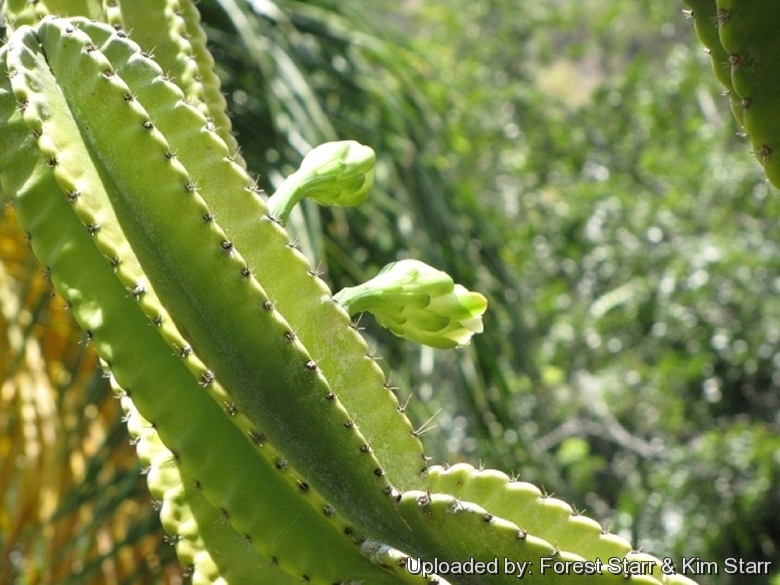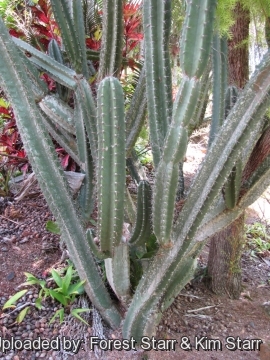
Cereus hexagonus Photo by: Forest Starr & Kim Starr
Flowers at Iao Tropical Gardens of Maui, Maui, Hawaii (USA). May 22, 2012.
Origin and Habitat: Cereus hexagonus occurs in Colombia, Brazil, French Guiana, Guyana, Surinam, Trinidad and Tobago, and Venezuela. It is cultivated for its fruit and as ornamental elsewhere in dry tropical and mild climate countries and often escaped.
Elevation ranges: From 0 to 1,700 metres above sea level.
Habitat and Ecology: In the Cañón del Río Chicamocha (Colombia) it is one of the most conspicuous and characteristic elements of the vegetation In Venezuela, it mainly grows on slopes in the Cordillera de la Costa. In Los Llanos, it grows in flatlands and small hills. In French Guyana it grows in sand dunes on the coast, forming large solid masses. It adapts well to moist environments. Fruits are dispersed by bats and birds. It is pollinated by hawkmoths. In Trinidad, the fruit bat Artibeus lituratus feeds on the skin and pulp of the fruit. It fruits July-August .This species has a low density where it occurs, but it is widely distributed. There are no known threats for this species.
Synonyms:
See all synonyms of Cereus hexagonus
back
Accepted name in llifle Database:Cereus hexagonus (L.) Mill.Gard. Dict., ed. 8. n. 1. 1768; Haw. Syn. Pl. Succ. 179.Synonymy: 15
back
Common Names include:
ENGLISH: Lady of the Night Cactus, Queen-of-the-night, Blue cereus, Six-angled Torch Thistle
FRENCH (Français): Cierge, Cactus cierge
LITHUANIAN (Lietuvių): Šešiabriaunis stulpenis
PORTUGUESE (Português): Pitahaya, Dato, Rainha da noite
SPANISH (Español): Reina de la noche, Pitahaya, Cacto columnar, Cirial, Cactus de Columnas, Cactus Columnar Miramar, Cirio, Miramar
Description: Cereus hexagonus is a treelike cactus that grows like a candelabrum with a short thick trunk from the top of which it sends out cylindrical shoots which as soon as they have room rise straight upwards in fluted pillars up to 15 metres height Such a plant with pillars rising side by side and almost touching one another has a curious resemblance to an organ with its pipes and thence its name organo
Stem: It forms a trunk 30-40 cm in diameter usually branching near the base. Branches cylindrical, usually strict and erect, but in old plants more spreading, made up of short joints 12 cm or more in diameter or more, glaucescent or light green.
Ribs: Usually 6 but sometimes only 4 or 5, occasionally 7, thin with wavy margins, 3 to 5 cm high, the margins undulate.
Areoles: About 2 cm apart, small, felted.
Spines: On young branches wanting or few, very short (2 to 3 mm long), but on old branches
often 8 to 10 or perhaps more in a cluster, very unequal, the longest ones to 6 cm long, when
young brown, but lighter in age.
Flower: White 20 to 25 cm long, its tube slender, 10 cm. long; uppermost scales green, short; outer perianth-segments lanceolate to oblong-lanceolate, 6 to 7 cm. long, short apiculate, tinged with purple; inner perianth-segments much thinner than the outer ones, white, oblong-lanceolate, 7 to 8 cm long; stamens very numerous; style green.
Fruit: Ovoid, 5.5 to 13 cm long, somewhat oblique, truncate or a little depressed at apex, pale red, a little glaucous, bearing small scattered areoles; rind thick; pulp white or pinkish, edible.
Seeds: Black.
Bibliography: Major references and further lectures:
1) Forest & Kim Starr Cereus hexagonus (cereus). Plants of Hawaii. <http://www.starrenvironmental.com>. Downloaded on 21 August 2014.
2) Nassar, J. 2013. Cereus hexagonus. The IUCN Red List of Threatened Species. Version 2014.2. <www.iucnredlist.org>. Downloaded on 22 August 2014.
3) Edward Anderson “The Cactus family” Timber Press, Incorporated, 2001
4) James Cullen, Sabina G. Knees, H. Suzanne Cubey "The European Garden Flora Flowering Plants: A Manual for the Identification of Plants Cultivated in Europe, Both Out-of-Doors and Under Glass" Cambridge University Press, 11/Aug/2011
5) David R Hunt; Nigel P Taylor; Graham Charles; International Cactaceae Systematics Group. "The New Cactus Lexicon" dh books, 2006
6) Clive Innes “Complete Handbook of Cacti and Succulents” Van Nostrand Reinhold Company, 01/Dec/1981
7) Urs Eggli, Leonard E. Newton: “Etymological Dictionary of Succulent Plant Names” Springer, Berlin/Heidelberg 2010
8) N. L. Britton, J. N. Rose: “The Cactaceae. Descriptions and Illustrations of Plants of the Cactus Family.” Volume II, The Carnegie Institution of Washington, Washington 1920
9) Park S. Nobel “Cacti: Biology and Uses” University of California Press, 2002
10) Jules Janick, Robert E. Paull “The Encyclopedia of Fruits and Nuts” CABI, 2008
11) Peter Hanelt, Richard Büttner “Mansfeld's Encyclopedia of Agricultural and Horticultural Crops: (Except Ornamentals)” Springer, 01/Jan/2001
12) Carl von Linné: "Species Plantarum" 1: 466, 1753
13) Véliz Pérez, M. E. 2008. “Cactáceas Guatemala” 1–129. Univ. de San Carlos de Guatemala, Guatemala.
14) Allorge-Boiteau, L. 2002. “Les cactées introduites à Madagascar.” Succulentes (France) 25(1): 9–16.
15) Dodson, C.H. & A.H. Gentry. 1978. “Flora of the Río Palenque Science Center: Los Ríos Province, Ecuador.” Selbyana 4(1–6): i–xxx, 1–628.
16) Dodson, C.H., A.H. Gentry & F.M. Valverde Badillo. 1985. Fl. Jauneche 1–512. Banco Central del Ecuador, Quito.
17) Funk, V. A., P. E. Berry, S. Alexander, T. H. Hollowell & C. L. Kelloff. 2007. “Checklist of the Plants of the Guiana Shield (Venezuela: Amazonas, Bolivar, Delta Amacuro; Guyana, Surinam, French Guiana).” Contr. U.S. Natl. Herb. 55: 1–584.
18) Steyermark, J.A. 1995. “Flora of the Venezuelan” Guayana Project.
19) Theodore H. Fleming, Alfonso Valiente-Banuet "Columnar Cacti and Their Mutualists: Evolution, Ecology, and Conservation" University of Arizona Press, 2002
20) George Crabb "Universal Technological Dictionary Or Familiar Explanation of the Terms Used in All Arts and Sciences: Containing Definitions Drawn from the Original Writers" in Two Volumes, Volume 1 Baldwin, Cradock & Joy, 1823
21) Sir Edward Burnett Tylor "Anahuac; or, Mexico and the Mexicans: ancient and modern" Longman, Green, Longman and Roberts, 1861
 Habit at Iao Tropical Gardens of Maui, Maui, Hawaii (USA). May 22, 2012. Photo by: Forest Starr & Kim Starr
Habit at Iao Tropical Gardens of Maui, Maui, Hawaii (USA). May 22, 2012. Photo by: Forest Starr & Kim Starr Habit at Iao Tropical Gardens of Maui, Maui, Hawaii (USA). May 22, 2012. Photo by: Forest Starr & Kim Starr
Habit at Iao Tropical Gardens of Maui, Maui, Hawaii (USA). May 22, 2012. Photo by: Forest Starr & Kim Starr Spines at Iao Tropical Gardens of Maui, Maui, Hawaii (USA). May 22, 2012. Photo by: Forest Starr & Kim Starr
Spines at Iao Tropical Gardens of Maui, Maui, Hawaii (USA). May 22, 2012. Photo by: Forest Starr & Kim StarrSend a photo of this plant.The gallery now contains thousands of pictures, however it is possible to do even more. We are, of course, seeking photos of species not yet shown in the gallery but not only that, we are also looking for better pictures than those already present.
Read More... Cultivation and Propagation: Cereus hexagonus is very easy to cultivate, easy to propagate, tolerates light frost, and produces numerous showy white flowers 15 cm long.
Growth rate: It grows quickly (a young plant will easily grow more than a 30 cm per year) and a plant grown in loose fertile soil with ample water availability may get up to 9 metres tall with dozens of branches in only 10 years.
Soils: For pot culture it needs standard cactus soil. Outdoors needs well drained spots, with deep soil, but will still thrive in less than ideal conditions. The species is sensitive to salinity.
Repotting: Since they are big-sized plants, they need plenty of space for their roots. Repotting should be done every other year, or when the plant has outgrown its pot. Use pot with good drainage.
Watering: Water regularly in summer, but do not overwater and allow to dry fully before watering again. Its roots are easily lost in pots that stay damp for any length of time. It should not be watered at all in winter. In the rest period no high atmospheric humidity!! Care must be taken with watering as they tends to become swollen and untidy in growth habit if given too much water and shade.
Fertilization: During the growing season enrich the soil using a fertilizer rich in potassium and phosphorous, but poor in nitrogen, because this chemical element doesn’t help the development of succulent plants, making them too soft and full of water.
Hardiness: Reputedly sensitive to frost, but less so if kept on the dry side prior to, and during, cold weather (hardy to -5° C for short periods). However some warmth throughout the year will increase the grower's success (minimum 5° to 8°C during rest season). In presence of high atmospheric humidity make sure that your Cereus hexagonus are not exposed to freezing temperatures, or they may die. Outdoors this plant is very adaptable, as long as you avoid excessive humidity in the winter months.
Exposition: Light shade when young, full sun later. Outside it likes strong sunshine, but is tolerant and do well with light shade during the hot Summer months, inside it needs bright light, and some direct sun.
Garden uses: Excellent as landscape or patio plant. It is suitable for “desert” gardens, in association with other xerophytes. Where the open air cultivation is not possible due to the climate, it is to be cultivated in pot in order to shelter it in winter. It look fine in a cold greenhouse and frame. Cereus hexagonus is particularly suited to make living hedges which are a feature in the landscape of the plains in Mexico. To make a fence people break off the straight lateral shoots of the height required and plant them closely side by side in a trench sufficiently deep to ensure their standing firmly. A hedge perfectly impassable is obtained at once the cactus rooting so readily that it is rare to see a gap. Slow growing and delicate cactus species can be grafted on Cereus hexagonus root stocks to provide faster growth.
Traditional uses: Fruits can be eaten fresh, dried or made into a juice.
Pests & diseases: It may be attractive to a variety of insects, but plants in good condition should be nearly pest-free, particularly if they are grown in a mineral potting-mix, with good exposure and ventilation. Nonetheless, there are several pests to watch for:
- Red spiders: Sensitive to red spider mite. Overhead watering is helpful in controlling mites.
- Mealy bugs: Occasionally mealy bugs they develop aerial into the new growth among the wool with disfiguring results, but the worst types develop underground on the roots and are invisible except by their effects.
- Scales: Scales are rarely a problem.
- Rot: Rot it is only a minor problem with cacti if the plants are watered and “aired” correctly. If they are not, fungicides won't help all that much.
Propagation: From cuttings in spring (let them dry till the ends callous well). Then replant them in fresh cactus soil that is ever so slightly moist, and keep them that way till they root), or by Seeds (Seeds should be sown in a well-drained soil mix. Surface sowing is the best; seeds germinate in 14-28 days at 25° C . The seedlings should not be disturbed until they are well rooted, after which they can be planted separately in small pots.
Your Photos

by Forest Starr & Kim Starr














